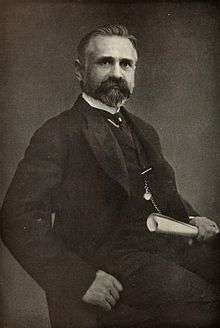Frank Damrosch
Frank Heino Damrosch (June 22, 1859 – October 22, 1937) was a German-born American music conductor and educator. In 1905, Damrosch founded the New York Institute of Musical Art, which later became the Juilliard School.

Life and career
Damrosch was born on June 22, 1859 in Breslau, Silesia, the son of Helene von Heimburg, a former opera singer, and conductor Leopold Damrosch. He came to the United States with his father, brother, conductor Walter Damrosch, and sister, music teacher Clara Mannes, in 1871. His parents were Lutheran (his paternal grandfather was Jewish).[1][2][3]
He had studied music in Germany under Dionys Pruckner. He studied in New York under Ferdinand von Inten. He also studied in Europe under Moritz Moszkowski.
He originally intended to adopt a business career, and to that end went to Denver, Colorado, but the musical impulse proved too strong, and in 1884 he was an organist, conductor of the Denver Chorus Club, and supervisor of music in the public schools.
For some years he was chorus master at the Metropolitan Opera House in New York. He also conducted the Mendelssohn Glee Club from 1885 to 1887. In 1892 he organized the People's Singing Classes, and he was also instrumental in founding the Musical Art Society of New York.
In 1897 he became supervisor of music in the public schools in New York. In 1898 Damrosch succeeded his brother Walter as conductor of the Oratorio Society, which he directed until 1912. During his career, he and his sister Clara Damrosch also taught at the Veltin School for Girls in Manhattan.[4]
In 1905 he founded and became director of the New York Institute of Musical Art, with the hopes of reproducing the quality of instruction found in European conservatories. In 1926, the Institute of Musical Art merged with the Juilliard Graduate School to form what is today Juilliard School. Damrosch's pupils included William Howland, long-time head of the music department at the University of Michigan,[5] and the prodigy pianist Hazel Scott.[6]
Damrosch died in New York City on October 22, 1937.[7] Damrosch Park, part of New York's Lincoln Center for the Performing Arts, is named in honor of the Damrosch family.
References
- Martin, G.W. (1983). The Damrosch Dynasty: America's First Family of Music. Houghton Mifflin. ISBN 9780395344088. Retrieved 2017-01-27.
- Damrosch, L.; Agócs, K. (2005). Symphony in A major. 54. A-R Editions. ISBN 9780895795823. Retrieved 2017-01-27.
- James, E.T.; James, J.W.; Boyer, P.S.; Radcliffe College (1971). Notable American Women, 1607–1950: A Biographical Dictionary. 3. Belknap Press of Harvard University Press. pp. 1–490. ISBN 9780674627345. Retrieved 2017-01-27.
- "The MacDowell Colony" (PDF). Signature: 27. June 2008. Retrieved February 3, 2017.
- "A Brief History | The Juilliard School". juilliard.edu. Retrieved 2017-01-27.
- Nate, DiMeo (December 19, 2016). "Episode 101: Promise". The Memory Palace.
- "Founder of Musical Institute and Brother of Walter Is Heart Stroke Victim". The New York Times. October 23, 1937. Retrieved 2010-09-17.
Frank Heino Damrosch, founder of the Institute of Musical Art, a member of a great family of musicians and a man who did much for the spread of musical learning in New York, died early yesterday afternoon of a heart attack at his home, 120 East Seventy-fifth Street. He was 78 years old.
- This article contains text from a work now in the public domain: "Etude Gallery of Musical Celebrities". Etude Magazine. August 1910.
External links
| Wikimedia Commons has media related to Frank Damrosch. |

- Damrosch-Tee Van collection, 1856-1969 at the Library of Congress